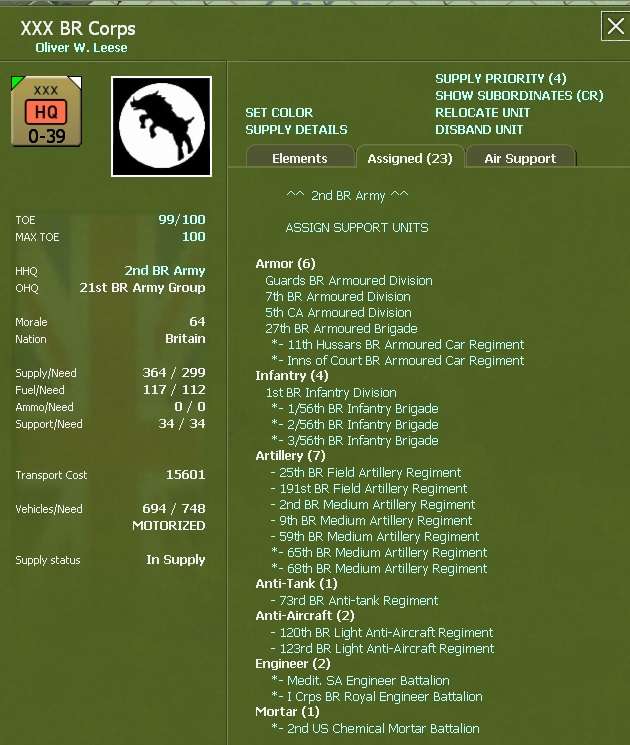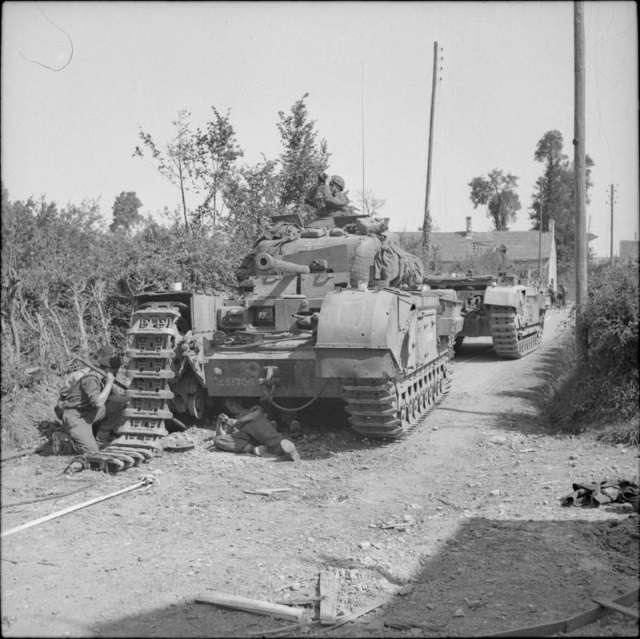From Arras to Aachen: Crossing the Maas: 19 August 1944 – 22 September 1944
Under heavy pressure from 1 US and 2 British Armies, and having sent a number of armoured formations to support their offensive in Burgundy, the German front came under increasing pressure in Belgium.
By 23 August, 4 Canadian Armoured had captured Liege and established a small bridgehead over the Maas.
XXX Corps reinforced this unexpected gain by drawing on its last reserves. 7 British Armoured exploited the Canadian victory and established firm control over the rail crossings. In turn, under pressure from SHAEF, the British tanks swung north and captured the pivotal Dutch city of Maastricht. This left them potentially isolated but the benefits of such a firm base for future operations over the Maas was obvious.

By the 26th, 11 British Armoured was also firmly over the Maas east of Liege as the Germans made major efforts to try to block the offensive by 1 US at Antwerp.

For these two weeks, actual fighting by the corps was limited but that changed dramatically in early September. The entire corps was now deployed on the Liege-Maastricht sector but the Germans had had time to reinforce their defensive line protecting Aachen.
Supported by I Corps' 51 Division, Guards Armoured, 7 and 11 British Armoured and 4 Canadian armoured clashed with 21 Panzer on the north-western approaches to Aachen on 4 September.

Unfortunately the Germans had used the delay imposed while SHAEF and 21 Army Group focussed on the capture of Antwerp. Despite constant air interdiction, and Bomber Command hitting its communications hub at Aachen, 21 Panzer had managed to split the British bridgehead into two separate sectors and to secure the east bank of the Maas between them. Worse Guards Armoured had been delayed by the fighting at Antwerp and arrived too late to take part in the battle.

As a result, the small town of Vise on the Maas became the focal point of the initial phase. Both sides realised that capturing this would allow the British to bring their superior numbers to bear.
The opening British plan was for 51 Division to force a crossing to the north of the town while 7 and 11 Armoured attacked the flanks of the German positions. To increase the pressure on the defenders, 11 Armoured was also ordered to capture the small town of Herve.
However, the plan fell apart almost immediately. 51 Division managed to force a small crossing but this was under constant German mortar and shellfire and it proved impossible to construct an emergency bridge strong enough to support a tank.

(evacuating wounded near Vise)
This would have been less of a problem if 7 Armoured had been able to make progress but it needed to force its way through the low wooded hills on the Dutch-Belgian border and became entangled with German strongpoints.

(tanks from 7 Armoured on the narrow roads between Maastricht and Vise)
The situation worsened when the commander of 21 Panzer realised that 11 Armoured was not pressing the southern defences of Vise with its full strength and was able to send reinforcements north.
In contrast to the claustrophobic fighting along the Maas, 11 Armoured faced a different problem at Herve. Sitting in the midst of open farmland the defenders had excellent visibility. Despite constant bombing, 11 Armoured could not suppress the defenders long enough to even reach the outskirts of the town.
By nightfall, the British formations had mostly fallen back to their start lines. A limited attempt was made on the 5th by 7 Armoured and 51 Highland to take Vise from the north but losses from the first day were too heavy and neither formation was strong enough to overcome the German resistance.

Badly beaten, the Corps handed over most of the defensive perimeter to I British Corps and pulled back over the Maas to rest and re-equip.
However, by 17 September, the Corps was back in action and by 22 September became the first allied formation to actually cross the German border.

Note: Since actually capturing a hex in Germany seems to mark the end of one phase of the game thought it might be useful to provide overall losses and the VP situation. I've marked up the data with the losses etc on 12 May 1944 (ie the turn before I invaded N France).

I think the Luftwaffe has been more robust in this game than it normally is. In particular I am not noticing that many more operational losses and that is a good proxy for when the axis need to shift away from relying on properly trained pilots. On my side, note the jump in losses of transport planes. I have done no paradrops since I did one at St Quentin (really to reinforce the spearhead) on 7 June. But I have been doing massive air re-supply of the Allied advance and XXX Corps has been a major beneficiary. A combination of being priority #4 for resupply, the others at this status are I British and one US corps (that has the bulk of their armour), plus being the focus for air re-supply has really kept their combat effectiveness relatively high.

Again I've added the pre-invasion figures for comparison. I've kept the bombing VP more or less the same (it shows as 3 due to the change in divisor in late 1944), Bomber Command is hitting manpower with a side order of rail junctions. 8 US is going for fuel, rail junctions and HI. 15 Air is performing well as I use it for raids on single hexes rather than wider areas – this seems to play to its strengths (or more strictly avoid its weaknesses).
I'm hoping to force the Rhine in the winter and at that stage to start picking up both City VP and bombing VP (as captured factories/manpower counts as destroyed).










































































































